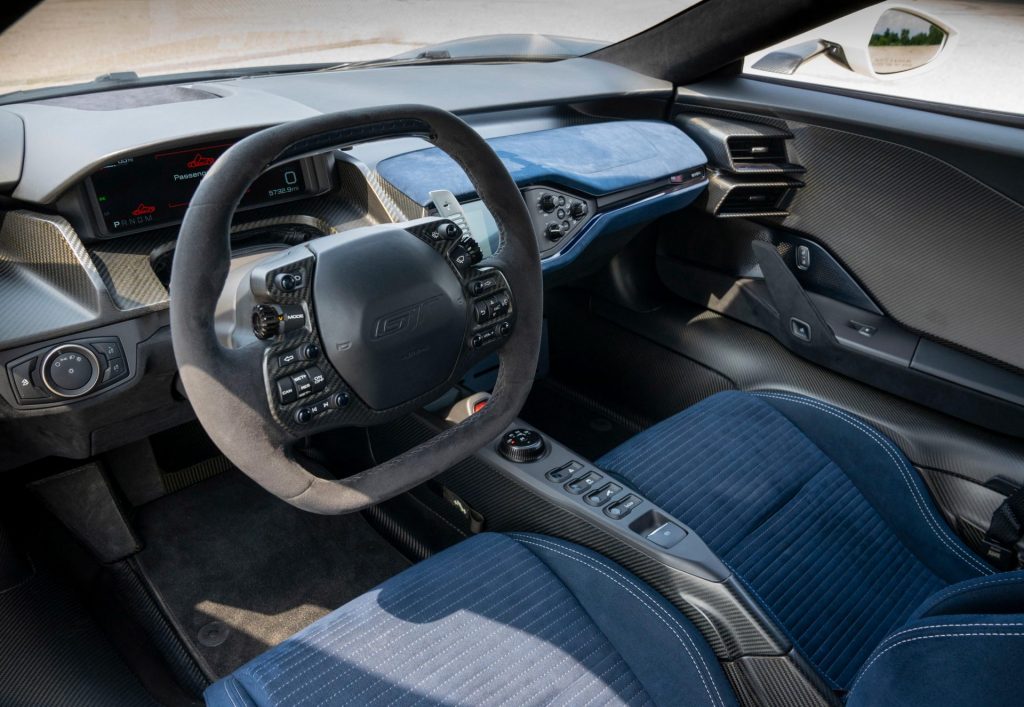This is 1963. Ford has set its sights on beating Ferrari and winning Le Mans. So, it begins development of its own race car. It needs to develop something that's frighteningly capable. A year later, on April 3, 1964, at the New York International Auto Show, the Ford GT prototype is unveiled. Only five prototypes of the model would be made, giving Ford the laurels it was looking for, not just first place, but a 1-2-3 at Le Mans in 1966. Fast forward to 2021: Only one GT with the original exterior livery has survived. And yet, this one and only one, gets its successor...
Back to the just five prototypes of the GT model. What was revealed in the New York Salon, the 1964, had chassis number GT/101. The others had chassis numbers GT/102, GT/103, GT/104, GT/105. These were the Ford's first vehicles who used the method of aerodynamic analysis in order to optimise performance in high speeds. These five prototypes were some of the most important cars ever produced by Ford and at the same time the foundation stone for the GT programme which culminated with the The company's "1-2-3" at Le Mans, making the GT the unique American supercar that won at Le Mans.

What happened to the 5 prototypes
Of the five Ford GT prototypes built, the one with the chassis number GT / 105 is the only one that "survived" over time with the right for the time of overseas livery.
The prototypes with frame number GT/101 and GT/102 were withdrawn after the crash tests at Le Mans and Monza - however this test was critical to the significant improvement of the GT/103, GT/104 and GT/105 chassis number prototypes.

Scoring the first victory in the GT category, the prototype GT/103 won at Daytona® in 1965 with Ken Miles and Lloyd Ruby behind the wheel, while the car with chassis number GT / 104 occupied the third place with Bob Bondurant and Ritchie Ginther. Both the prototype with chassis number GT / 103 and the GT / 104, have been repainted and are currently on display at Shelby Museum in Boulder, Colorado.
Price tax
These cars symbolize the pioneering engineering development that continues today within Ford with the 2022 Ford GT Heritage Edition. As tribute to the Ford GT, the prototype vehicle that gave life to the model's development programme before more than half a century, Ford presented the 2022 Ford GT '64 Prototype Heritage Edition. The vehicle limited production is inspired by the 1964 Ford GT prototype that debuted at the 1964 New York International Auto Show.

"This is the first Ford GT Heritage Edition that goes beyond celebrating race wins - this edition goes even deeper and honours Ford's oldest supercar heritage." explains the Ford GT program manager Mike Severson, and continues: "The Ford GT '64 Prototype Heritage Edition is a modern version of the original, and you certainly can't go wrong with the car you're paying homage to."

The Ford GT '64 Prototype Heritage Edition shared the spotlight at the Monterey Car Week, along with the unique 1964 Ford GT prototype which has survived, which has a GT/105 chassis number and still has its original exterior livery.
Triple strip and carbon fibre

The Ford GT '64 Prototype Heritage Edition is externally adorned by the Wimbledon White colouring and Antimatter Blue graphics, as well as from a triple, racing-type lane running across the roof of the car. The exposed Carbon fibre components are more than perceptible, including the wheel carbon, which are a unique touch for the Ford GT with a diameter of 20 inch and blue paint.

From carbon fibre are also made in the front splitter, side skirts, the outer part of the mirrors, the engine cover louvres and the rear diffuser, which has a glossy coating. The Brembo brake calipers® are lacquered in silver with black graphics, while the presence of black wheel bolts is noticeable, further modernizing the aesthetics.

Carbon is found as a material and in the cabin of the car - namely the side markings, low on the A-pillar, on the centre console, and on the relevant label. The carbon fibre seats adorned with the material Lightspeed Blue Alcantara and silver stitching, while their surfaces and the headrests are embossed with the GT logo.

Ο instrument panel surrounded by Ebony leather and Lightspeed Blue Alcantara, ενώ οι κολώνες και το εσωτερικό τμήμα της οροφής από Ebony Alcantara. Τα διακοσμητικά Antimatter Blue στον πίνακα οργάνων, οι χειρολαβές των θυρών και το κάθισμα X-brace ταιριάζουν αισθητικά με τον σχεδιασμό των μοναδικών τροχών του αυτοκινήτου. Το steering wheel διαθέτει επένδυση από Ebony Alcantara και μαύρες ραφές, ενώ τα paddles του αυτόματου κιβωτίου διπλού συμπλέκτη είναι για την περίσταση γυαλισμένα.

«Υπάρχουν πολλές σημαντικές στιγμές στην ιστορία του Ford GT που έχουμε γιορτάσει. Όμως, η ομάδα μας ήταν ομόφωνη πιστεύοντας ότι, αυτή τη φορά το αρχικό πρωτότυπο ήταν το κατάλληλο όχημα», λέει ο Severson. «Το πρωτότυπο του 1964 απελευθέρωσε τη δημιουργική ιδιοφυία της ομάδας Ford Advanced Vehicles και άνοιξε το δρόμο για το πρόγραμμα Ford GT. Και έτσι όλα άρχισαν να παίρνουν το δρόμο τους».







